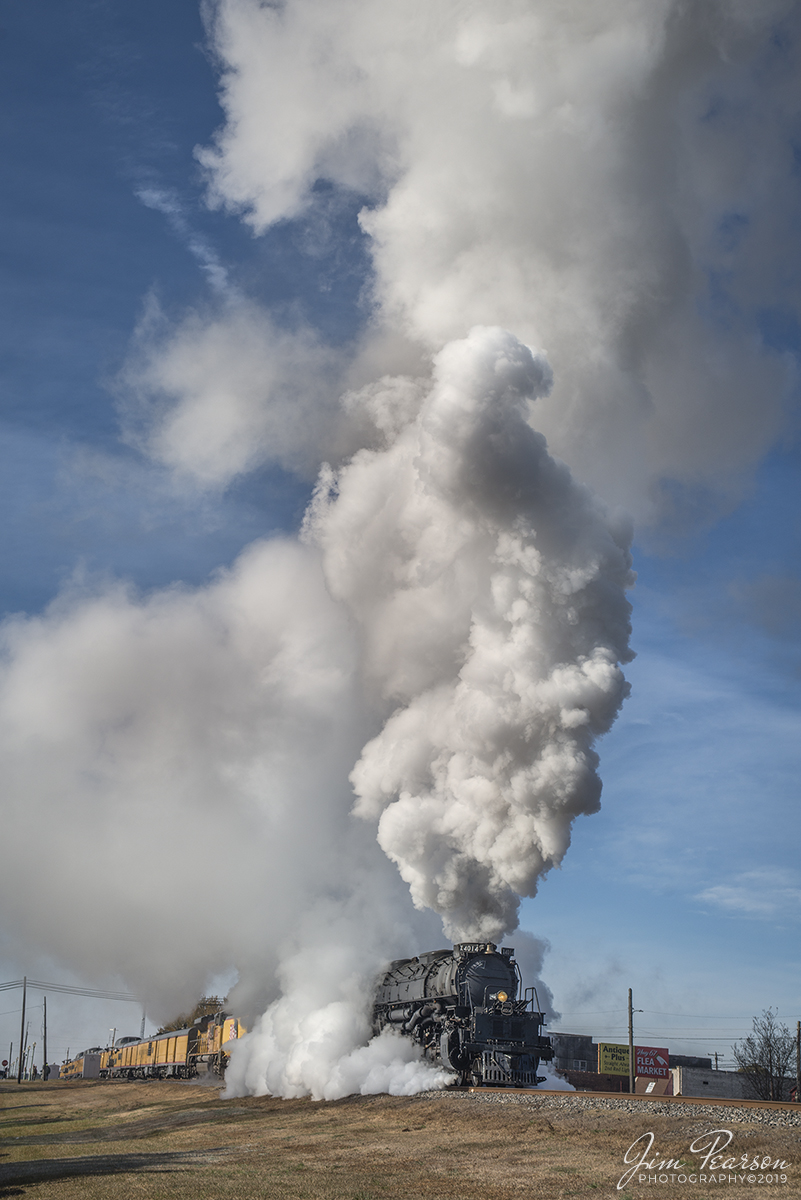This is one of the last images from my DJI Air 2 drone before it ended up in the top of a 30′ oak tree the next day at Dexter, MO after a Fly Away in 2021.
In this shot Engineer Ed Dickens waves from the cab as Union Pacific’s 4014, the Big Boy, passes under the signal bridge in downtown McRae, Arkansas on Friday, on August 27th, 2021, as they head north on the UP Hoxie subdivision on its way to Popular Bluff, MO.
The Big Boy is an articulated 4-8-8-4 steam locomotive which was manufactured by the American Locomotive Company (ALCO) of Schenectady, New York in 1941. There were a total 25 of these giants built and of the eight remaining locomotives this is the only operational one.
According to Wikipedia: “The locomotive operated in revenue service until 1959, when it was donated to the Railway and Locomotive Historical Society in late 1961 and thereafter displayed in Fairplex at the RailGiants Train Museum in Pomona, California.
In 2013, UP re-acquired the locomotive and launched a restoration project at their Steam Shop in Cheyenne, Wyoming. In May 2019, No. 4014 was operated for the first time after sitting dormant for almost six decades.
It ran its first excursion, double-headed with Union Pacific 844, three days later on May 4, 2019. Now part of the Union Pacific’s heritage fleet, it now operates in excursion service, in addition to hauling revenue freight during ferry moves.”
The Big Boy is currently on a month-long tour around the Midwest through, Arkansas, Colorado, Kansas, Illinois, Louisiana, Missouri, Nebraska, Oklahoma, Texas, and Wyoming before heading home to Cheyenne, Wyoming on September 7th.
Tech Info: Wide Photo: DJI Mavic Air 2 Drone, RAW, 4.5mm (24mm equivalent lens) f/2.8, 1/800, ISO 100, August 27, 2021.













![November 13, 2019 - Union Pacific's 4014 Big Boy pulls it's train north out of Union Station at Little Rock, Arkansas on a cold fall afternoon.
Union Pacific has billed this move as The Great Race Across the Southwest as the train is making a circle around the southwest over a six week or so period hitting Arkansas, Arizona, California, Colorado, Kansas, Missouri, Nevada, New Mexico, Oklahoma, Texas, Utah and Wyoming.
According to Wikipedia: Union Pacific 4014 is a four-cylinder simple articulated 4-8-8-4 Big Boy-type steam locomotive owned and operated by the Union Pacific Railroad. Built in 1941 by the American Locomotive Company (ALCO) of Schenectady, New York, No. 4014 is the only operating Big Boy of the eight that remain in existence.
The locomotive operated in revenue service until 1959. It was donated to the Railway and Locomotive Historical Society in late 1961 and thereafter displayed in Fairplex in Pomona, California. In 2013, Union Pacific re-acquired the locomotive and launched a restoration project at their Steam Shop in Cheyenne, Wyoming.[citation needed] In 2019, No. 4014 was operated for the first time after it sat dormant for almost six decades. Part of Union Pacific's heritage fleet, it now operates in excursion service, in addition to hauling revenue freight during ferry moves.
Tech Info: Fuji XT1, Nikon 18mm, 1/350sec, f/7.1, ISO 200.
#fuji #UP4014 #UPSteam #unionpacificbigboy #bigboy #unionpacificrailroad](https://www.jimpearsonphotography.com/wp-content/uploads/2025/01/WEB-11.13.19-UP-4014-Departs-Union-Station-2-Little-Rock-AR.jpg)
![Film Wednesday – Five Santa Fe Warbonnet units lead a loaded intermodal as it approaches one of the many tunnels in the Tehachapi mountains of California that was shot sometime in the mid 1990’s.
According to Wikipedia: The Atchison, Topeka and Santa Fe Railway (reporting mark ATSF), often referred to as the Santa Fe or AT&SF, was one of the largest Class 1 railroads in the United States between 1859 and 1996.
The Santa Fe was a pioneer in intermodal freight transport; at various times, it operated an airline, the short-lived Santa Fe Skyway, and the Santa Fe Railroad tugboats.[2] Its bus line extended passenger transportation to areas not accessible by rail, and ferryboats on the San Francisco Bay allowed travelers to complete their westward journeys to the Pacific Ocean. The AT&SF was the subject of a popular song, Harry Warren and Johnny Mercer's "On the Atchison, Topeka and the Santa Fe", written for the film The Harvey Girls (1946).
The railroad officially ceased independent operations on December 31, 1996, when it merged with the Burlington Northern Railroad to form the Burlington Northern and Santa Fe Railway.
Tech Info: Camera, Nikon F3, Kodachrome Slide Film, no other data recorded
#slidescan #filmphotography #trains #railroads #jimpearsonphotography](https://www.jimpearsonphotography.com/wp-content/uploads/2025/01/WEB-1995-KR-Slide-SF-in-Techachapi-1-1170x748.jpg)





